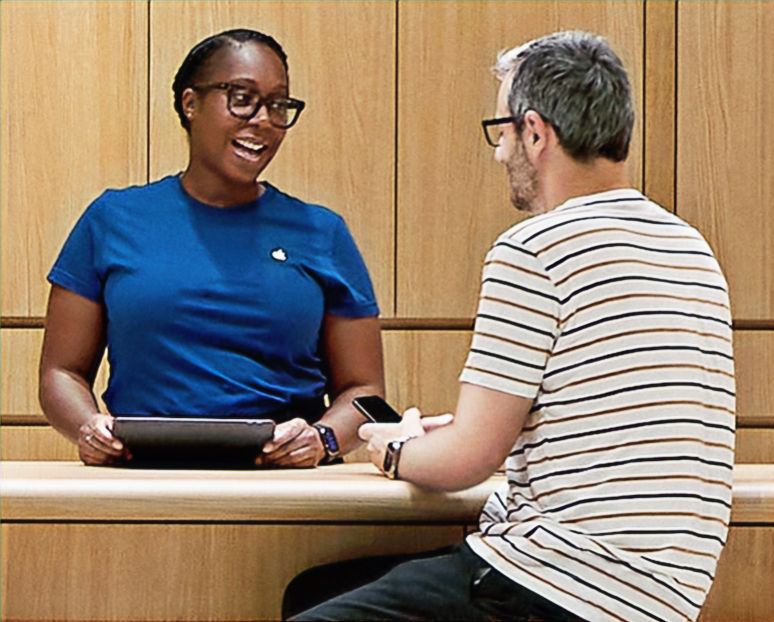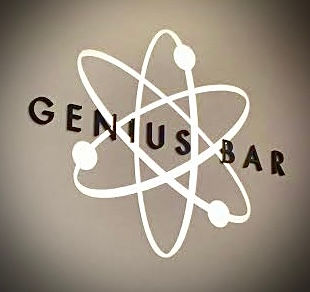Apple’s Genius Bar: Where Technology Meets Charm.
- T
- Sep 7
- 4 min read
We’ve been orbiting in Apple’s universe since 2008 - the era of the chunky white MacBook, the spinning iPod wheel, and an iPhone that felt less like a pocket computer and more like a glimpse into the future. Back then, Apple was still proving it could reinvent the everyday object. Fast forward to now, and those rectangles of glass and metal aren’t just tools - they’re cultural markers, status symbols, and in some cases, emotional crutches.
But here’s the thing: the real magic of Apple isn’t in the flawless demo moments. It’s in the messy, inconvenient, and occasionally heart-stopping glitches that follow. That’s when you discover the other piece of Apple theatre - the Genius Bar.
Far from being just a customer service counter, it’s a fascinating hybrid:
A sanctuary for the frazzled - where you’re not alone in accidentally baptising your MacBook with coffee.
A confidence clinic - because nothing levels the playing field like watching a CEO and a uni student both fumbling with iCloud.
An understated magic show - where technicians revive lifeless devices with the flick of a diagnostic tool and a charging cable you’ll never manage to buy in-store.

And if you look closer, the Genius Bar is less about repair and more about psychology. It soothes the existential panic of being digitally stranded, replaces guilt with reassurance (“it happens to everyone”), and restores not just your device, but your sense of being a competent human in a hyper-connected age.
Case in point: One of our MacBook Air Pros staged what can only be described as a digital rebellion. One moment I was mid-sentence, polishing a story with the smug confidence of a well-behaved cursor, and the next - blackout. The screen went dark, as though auditioning for a gallery piece in minimalist despair. It wasn’t just a glitch; it was a power play.
Panic arrived right on cue. I pictured a weekend marooned in tech purgatory: unsaved drafts evaporated, deadlines turning feral, and my productivity graph collapsing like a bad IPO. It was a reminder of how deeply Apple has hardwired itself into our lives. Since the late 2000s, the MacBook has evolved from a stylish laptop into a creative lifeline - the tool writers, designers, students, and CEOs alike swear by. When it fails, it doesn’t just break a device; it interrupts an ecosystem of thought, memory, and workflow.
And that’s when you remember the quiet ace up Apple’s sleeve: the Genius Bar. Not just a repair counter, but a peculiar cultural invention - part emergency ward for broken tech, part therapy session for broken spirits. You walk in clutching your inert device like a wounded bird, and leave with it miraculously resuscitated - or at least with the comforting sense that someone clever has taken ownership of your catastrophe.
Walking in, I was met with the kind of calm smiles usually reserved for yoga instructors and ER nurses - a wordless assurance that no matter how dire my situation looked, I wasn’t their first crisis of the day. (Which is true: Apple Geniuses reportedly handle millions of appointments globally every year, many of them less “rare catastrophe” and more “spilled latte.”)
My laptop was gently escorted to the table of quiet miracles - a space designed less like a service counter and more like a stage. There, a Genius with the poise of a zen master and the diagnostic dexterity of a Formula 1 pit crew began their work. The verdict? Not a terminal failure, but a display cable that had slipped just slightly out of place. A microscopic misalignment, dramatized by my MacBook into an existential blackout.
With a few deft maneuvers, a sprinkling of technical jargon (that somehow comforted rather than alienated), and the kind of confident silence that only comes from solving hundreds of these puzzles a week, the screen snapped back to life. Pristine. Obedient. As if it hadn’t just staged a theatrical fainting spell.
And that’s the brilliance of the Genius Bar: it doesn’t just fix hardware. It restores belief. You leave not just with a working laptop, but with your faith in technology - and, perhaps more importantly, in yourself as a vaguely competent digital citizen - renewed. Apple’s products may dazzle on launch day, but it’s these small, human-scale resurrections that keep the mythology alive.

That, in essence, is the Genius Bar. It’s never just about swapping a part or coaxing a stubborn screen back to life - it’s about transformation. Frustration becomes delight, panic dissolves into calm, and bewilderment is neatly reframed as “learning.” The Geniuses don’t simply repair hardware; they act as translators of cryptic error codes, patient educators of overlooked shortcuts, and, occasionally, life coaches in blue tees. You leave not only with a functional device, but with a strange sense of having leveled up - smarter, cooler, and just a little more “in the club.” No surprise then that customer-satisfaction scores hover at 90% and beyond.
AppleCare+ and its shinier cousin, AppleCare One, take this alchemy and industrialize it. A cracked screen that would normally sting at $799 suddenly becomes a $45 shrug. A fading battery? Swapped without drama. Middle-of-the-night meltdown? There’s 24/7 access to a calm voice on the line. And if your household resembles a small Apple showroom, AppleCare One bundles it all into one neat subscription - an operating system for peace of mind, as much as for devices.
But what really defines the Genius Bar isn’t just technical prowess. It’s the theater of reassurance. The moment you sit down, you’re enveloped in Apple’s most underrated product: confidence. The Geniuses restore more than your device - they restore your digital dignity. It’s customer service as performance art: minimal fuss, maximum charm, and just enough sleight of hand to make you wonder if the experience itself was more enjoyable than the technology it saved.
In an industry addicted to automation and chatbots, the Genius Bar feels almost radical. Apple has proven that the human touch still has a market premium - especially when delivered with the precision of a Swiss watchmaker and the warmth of a trusted confidant. Because sometimes, the real genius isn’t in the silicon or the software. It’s in the choreography of people who turn tech disasters into little moments of theatre, and somehow send you back into the world feeling like the clever one.
—-
Words by AW.
Photos courtesy of Apple.





